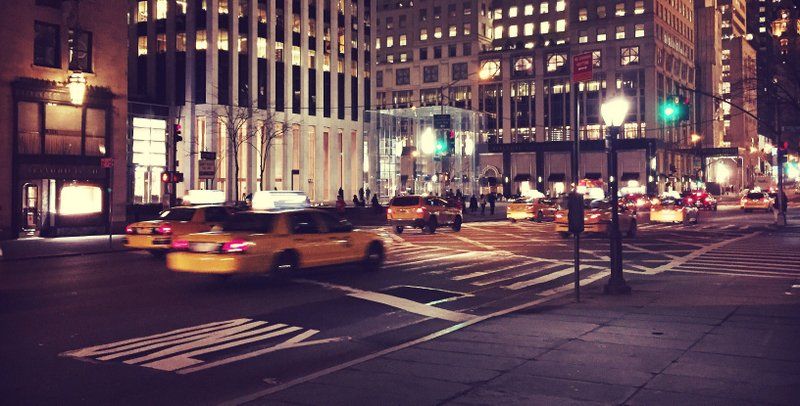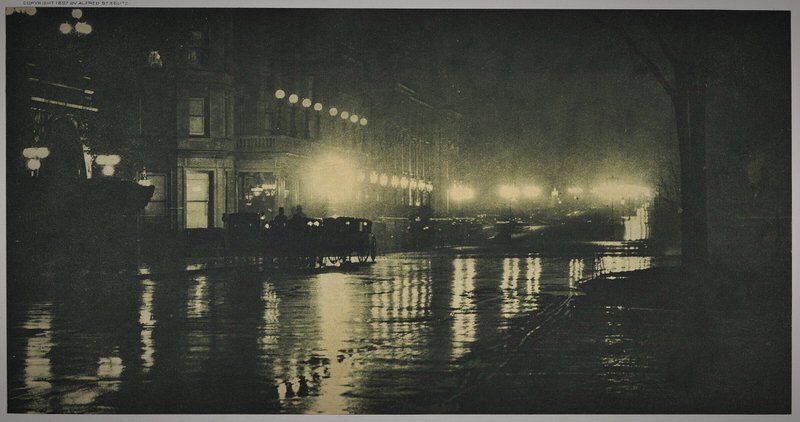NYC's Long-Awaited Davis Center Opens in Central Park
A stunning new facility at Harlem Meer opens to the public this weekend!


You’re at the intersection of 5th Avenue and 59th Street looking southeast from the southern tip of Central Park. Nearly one hundred and twenty years linger between the snapping of these two shots (above and below). Today, taxi cabs fly by the entrance to the underground Apple store. In 1897, however, horse-drawn carriages rattled past the Hotel Savoy, a luxurious, 12-story structure commanded the Apple store’s lot, at the General Motors building, from 1892 to 1927.
The old photograph is captioned “The Glow of Night.” It was originally taken by Alfred Stieglitz (1864-1946) and reprinted in a portfolio of his work called Picturesque Bits of New York and Other Studies (1897). Interestingly, only four of the “bits” were actually shot in New York City. The other eight captured scenes in Paris, Venice, Holland, and Germany.
 The same location today. Photo by Riff Chorusriff. 2017 (before the Apple Store cube was removed recently).
The same location today. Photo by Riff Chorusriff. 2017 (before the Apple Store cube was removed recently).
Aiming for publicity, publisher Robert Howard Russell placed a two-page ad for the collection in one of his own catalogs. The listed price? $10. However, if you had to have the “Edition-De-Luxe in a special binding, limited to forty copies of the first impressions, each plate signed by Mr. Stieglitz,” you’d need to come up with $25. If the expense of neither book option appealed to you, though, Russell offered alternatives. You could buy “single proofs of any of the plates” for $2 or “artist’s proofs, signed by Mr. Stieglitz” for $5. Unfortunately, not many of the books sold. Some sources claim it was only 25 copies. The single proof options weren’t successful either.
In 1898, The Photographic Times—Walter E. Woodbury’s “illustrated monthly magazine devoted to the interests of artistic and scientific photography” – wrote this summary of Picturesque Bits:
Mr. Stieglitz is undoubtedly the pioneer of pictorial photography in this country, and in this portfolio we have a collection of twelve of his best works. The reproductions are on plate paper 14 x 17 inches, and printed by the photogravure process….
“The Glow of Night” is a photograph taken at midnight, and gives a perfect reproduction of New York at that hour. The electric lights and the reflection on the wet pavements are all rendered with startling fidelity.
In his 1898 appraisal of Picturesque Bits for Camera Notes—a journal circulated by the Camera Club of New York from 1897 to 1903—William M. Murray remarked that
Each plate is presented in a color appropriate to the subject. We might take exception to the tint employed in the “Glow of Night,” where the desire to reproduce the yellow glare of the incandescent and other lights glowing through the fog and mist of a rainy night on Fifth Avenue has led to the employment of colors that are singularly disagreeable.
Perhaps our photographic experience heightens this repugnance, because the tones, ranging from yellow to a somewhat dirty greenish black, recall the effect of an aristotype badly sulphurized in a combined toning and fixing bath. It is possible that the print will be more satisfactory to an artist, or to an art lover, who has never dabbled in photography.
Murray’s critique, though, was probably more directed at Russell than Stieglitz. Apparently one of the techniques Russell used in reprinting “The Glow of Night” was chine-colle. According to the 15th Street Gallery in Boulder, Colorado:
Chine-colle is a special printmaking technique in which paper of a different color or texture is adhered to the overall piece…the paper is actually bonded, not just glued, to the print. It can, at times look like its is embossed.
So, most likely, Russell achieved what Murray derided as “colors that are singularly disagreeable” by printing Stieglitz’s photo on a sheet of yellow paper. Unfortunately, that move didn’t provide Stieglitz cover from being singled out.
Writing in the June 1898 edition of The Photographic Times, art critic Sadakichi Hartmann also took issue with Russell’s reproductions; but, nonetheless, decided Stieglitz’s work should be assessed on what was ultimately published and people could actually examine: “It will after all be more advisable [to criticize the prints in Picturesque Bits] than to criticize the originals themselves…which few will [ever] have an opportunity to study.” So what did Hartmann conclude from his viewing? Well, have a look:
The [book] contains two complete failures: “The Incoming Boat,” which is in every respect commonplace, and “The Glow of Night,” Fifth Avenue with a full view of the Savoy with its long rows of lighted candelabra reflected on the wet pavement, which is utterly spoiled by the attempt of lending it a color effect, a cheap yellow monotony which has robbed the otherwise excellent picture of all its delicacy and vibratory force. Reproductions of works of art are always most dignified in black, or at least one dark tonal color.
But bad reviews and poor sales didn’t tame Stieglitz. In his continuing effort to put photography on par with painting, he would mount the first retrospective exhibit of his work in May 1899. It would be held at the Camera Club of New York—then on the eighth floor of the Bancroft Building at 3-7 West 29th Street—and boast 87 prints from 1885-1899. In a lengthy analysis for The New York Times on June 4, 1899, resident art and literary critic Charles DeKay declared that “anybody can use a camera,” but “one rarely feels the artist behind the camera.” Alfred Stieglitz was his exception:
Mr. Stieglitz is opening up new vistas in an art which suffered at first through the inartistic natures of its expounders, but has shown in the hands of artists a field for itself and a reason for its existence beyond the merely mechanical purpose of reproducing facts coldly without the touch of art.
—–

Photo by Alfred Stieglitz, 1897. Print by R.H. Russell. Untouched version. Image via nypl.org.
Next, read about the General Motors building at this same location, which was sold for $2.8 billion in 2008.
[Author’s Note]: While preparing this post, I retouched “The Glow of Night” to make it sharper and match the hue of my own image. Russell’s print was faded and yellow-green so I wanted you to see it more clearly. Afterward, though, I was surprised to discover that other people had the same thought about changing the tint as I did.
Subscribe to our newsletter